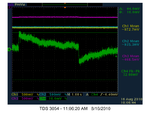Robotduck
Member level 2

MOS (p type)
1) General Question: Why thin charge sheet on the metal side ? Is it because positive bias on metal side will attract the electrons leaving immobile positive ions at the metal -oxide interface ? If yes then why not we get this thin charge sheet at surface of the metal where we have the positive bias ?
2) Figure a) and b) are the cases of strong inversion. Figure b)-For high frequency signals, electrons at the semiconductor oxide interface do not get enough time to change ( I follow that ), but how come the charge in the bulk close to the depletion region changes with these high frequency signals and causes the change in the depletion region in the bulk ( which is bothering me )?
3)In Figure c) if we change the voltage ( ranging from accumulation to strong inversion )quickly, then the system does not have enough time for strong inversion but again - how come the charge in the bulk is responding with this change ?
4) How come the charge in the Metal is responding to these changes in figure b) and c) ? This also has the electrons as a majority carriers ?
Thank you in advance for taking time to answer these questions !!
1) General Question: Why thin charge sheet on the metal side ? Is it because positive bias on metal side will attract the electrons leaving immobile positive ions at the metal -oxide interface ? If yes then why not we get this thin charge sheet at surface of the metal where we have the positive bias ?
2) Figure a) and b) are the cases of strong inversion. Figure b)-For high frequency signals, electrons at the semiconductor oxide interface do not get enough time to change ( I follow that ), but how come the charge in the bulk close to the depletion region changes with these high frequency signals and causes the change in the depletion region in the bulk ( which is bothering me )?
3)In Figure c) if we change the voltage ( ranging from accumulation to strong inversion )quickly, then the system does not have enough time for strong inversion but again - how come the charge in the bulk is responding with this change ?
4) How come the charge in the Metal is responding to these changes in figure b) and c) ? This also has the electrons as a majority carriers ?
Thank you in advance for taking time to answer these questions !!


